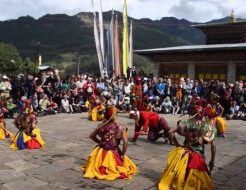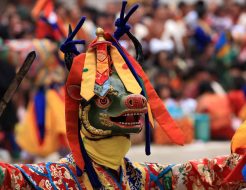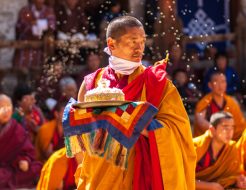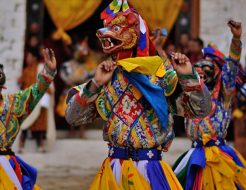One of the four pillars of Bhutan’s development philosophy of Gross National Happiness is the preservation of its environment.
It is quite interesting to note that some of the crucial development activities are also compromised if they were found to be impacting the environment.
From the time immemorial, people of Bhutan have learned to live with the nature in harmony. They believe mountains, forests, and rivers as abodes of Gods and Goddesses.
Not only human life, the Bhutanese people believe that all forms of life are precious and sacred. The belief has contributed a lot to keeping Bhutan’s environment intact.
The recently adopted Constitution of Bhutan mandates to have the minimum of 60% of the country under forest coverage. Today, forests constitute 72% of the country.
There are more than 3,281 plant and 770 bird species making Bhutan one of the top 10 bio-diversity hotspots in the world.
Abound with the diversity of flora and fauna, Bhutan is a home of some of the most endangered animals on the planet like Red Panda, Takin, Golden Languor and Snow leopards.
Also, the country prides on its multiple medicinal plants. To foreigners, Bhutan was once known as a land of the medicinal hub.
JIGME DORJI WANGCHUCK NATIONAL PARK
This is the largest protected area with 4329 Sq Km. It covers parts of Paro, Thimphu, Punakha and almost all of Gasa Dzongkhag/District. The park is a habitat for many endangered species like the Snow Leopard, Takin, Blue Sheep, Musk Deer, Red Panda, Himalayan Black Bear, Leopard, Wild Cats, Wild dogs, Sambars, Barking deer, Pikas, and Serow.
ROYAL MANAS NATIONAL PARK
This is located in South Central Bhutan and covers 1023 Sq Km and adjoins the Jigme Singye Wangchuck National Park to the north and Indian’s Manas National Park and Tiger reserve to the south. Together they cover 5000 Sq Km from the plains to the Himalayan peaks. These areas have been protected since 1966. It is home to Rhinos, Asian Elephants, Water Buffalos, Bengal Tigers, Leopards, and the Golden Langur. There are 362 species of birds. Although sounds tempting to visit, it is advised that tourists not travel here because of political turmoil in that region posing security concerns. Some two years ago Bhutan has been seeing the presence of Tigers as far north as Thimphu!
JIGME SINGYE WANGCHUCK NATIONAL PARK
The 1400 Sq Km park protects the Black Mountain Ranges that separate eastern from western Bhutan. Tigers, Black Bears, Red Pandas, Langurs, Leopards and 449 species of birds have been recorded here. Phobjikha Valley also falls within this region.
PHIBSOO WILDLIFE SANCTUARY
Set up in 1974, about 278 Sq Km was set aside to protect the only natural remaining Sal forests in the country. The Chital deer, Elephants, Guars, Tigers, the Golden Langurs, and Hornbills can be found here.
PHRUMSENGLA NATIONAL PARK
This is 768 Sq Km and covers the area between Bumthang and Mongar that protects the growth of ancient fir and chirpine in this temperate forest. It is home to more or less the same animals like the Jigme Singye Wangchuck National Park including some rare and exotic birds.
BOMDELING WILDLIFE SANCTUARY
This is a 1545 Sq Km area that protects most of Trashi Yangtse Dzongkhag/District that is home to Blue Sheep, Snow Leopards, Red Pandas, Tigers, Leopards, Black Bears, numerous species of birds, and the Black Necked Cranes.
SAKTEN WILDLIFE SANCTUARY
This might sound incredible but assuming that the Yeti exists, this area is said to be the habitat of the Yeti. This is also home to the Brockpas, an indigenous group of nomadic people, and home to a varied species of rhododendrons.
JOMOTSHANGKHA WILDLIFE SANCTUARY
Just like in the Manas region, where animals roam freely between the Indian Manas and the Bhutan Manas, the southeastern region of Bhutan has been protected for animals that roam freely between a reserve in India and in Bhutan.
JIGME KHESAR STRICT NATURE RESERVE
This is an area of about 664 Sq Km that lies in the western region of Haa Dzongkhag/District where the Torsa river entering from Tibet. It was set aside to protect the pristine Alpine forests of that region. There are no people living there.
Book a Tour

Bhutan Naked Festival 2024
The Jambay Lhakhang, situated in Bumthang and en route to the Kurjie Lhakhang, is the venue for…
Start Date: 15th November 2024
End Date: 18th November 2024
Destination: Jambay Lhakhang, Choekhor, Bumthang

Bhutan Thimphu Festival Tour 2024
One of the biggest festivals in the country is the Thimphu Tshechu. This Thimphu festival tour is…
Start Date: 13th Sept 2024
End Date: 15th Sept 2024
Destination: Tashi Chhodzong, Thimphu

Punakha Festival Tshechu 2024
Punakha, situated in the western part of Bhutan, serves as the winter residence of the Je Khenpo,…
Start Date: 19th - February 2024
End Date: 21st February 2024
Destination: Punakha Dzong

Paro Bhutan Festival 2024
The Paro Festival, an annual event held every spring, stands as one of the most vibrant and…
Start Date: 21st March, 2024
End Date: 25th March, 2024
Destination: Rinpung Dzong, Paro
CONTACT US
- homeThimphu, Bhutan
- emailbookbhutantour@gmail.com
- emailinfo@bhutantouragency.com
- +975-17614054
- +975-02-340662
- +975-17614054
- rdtamang




